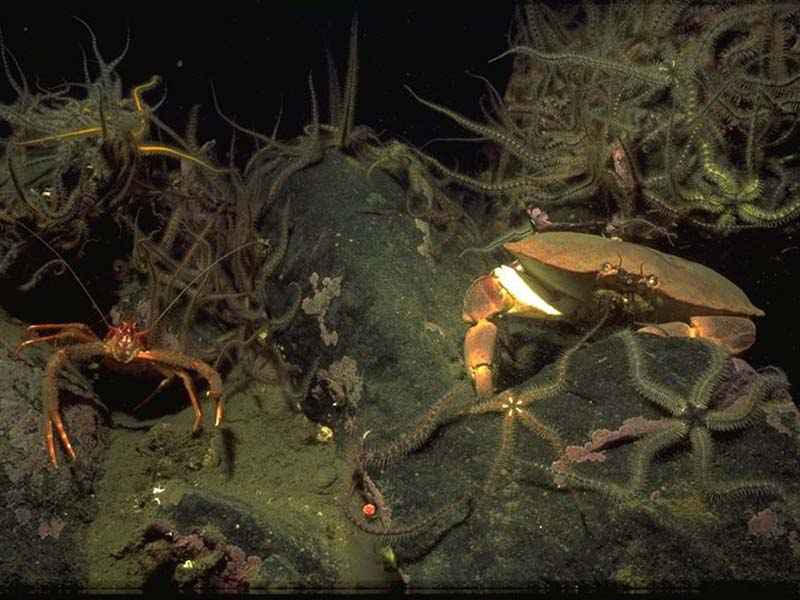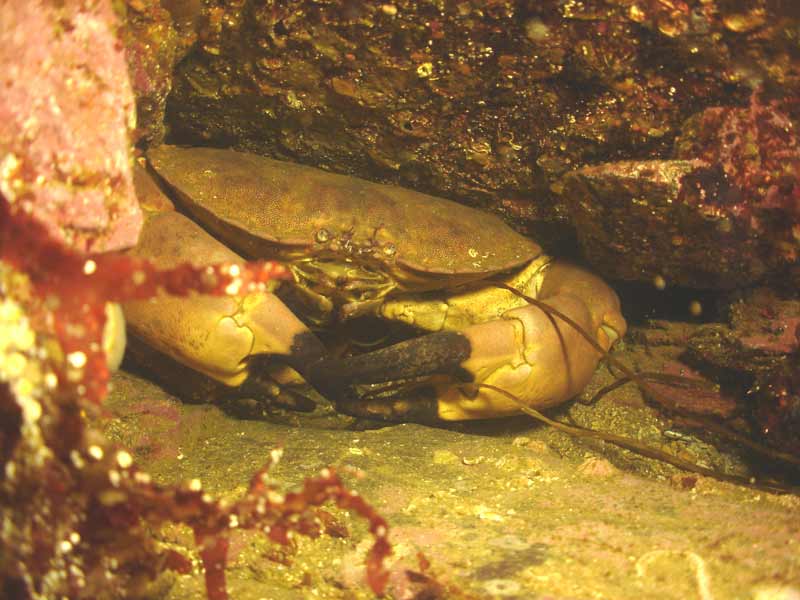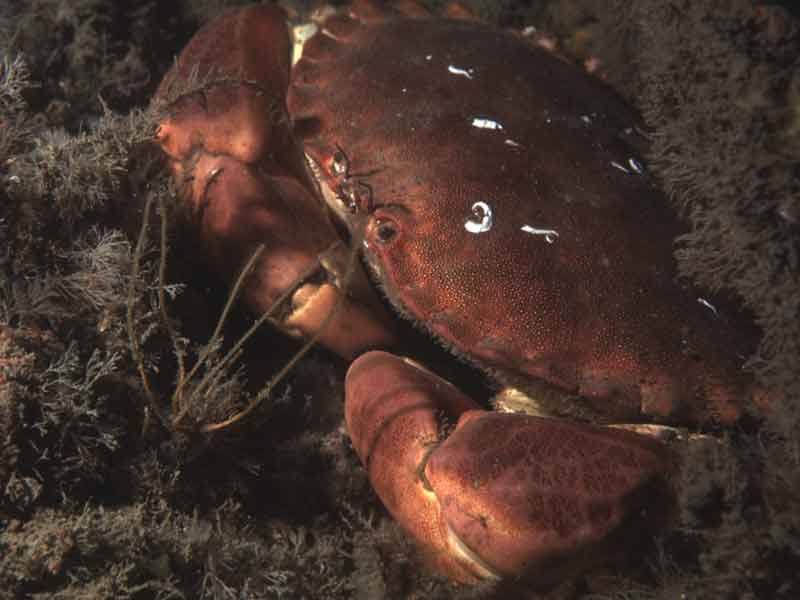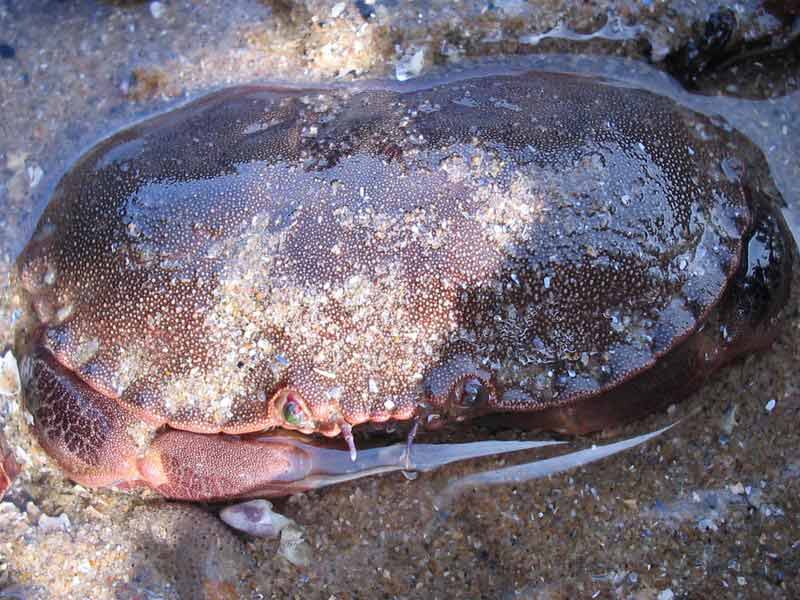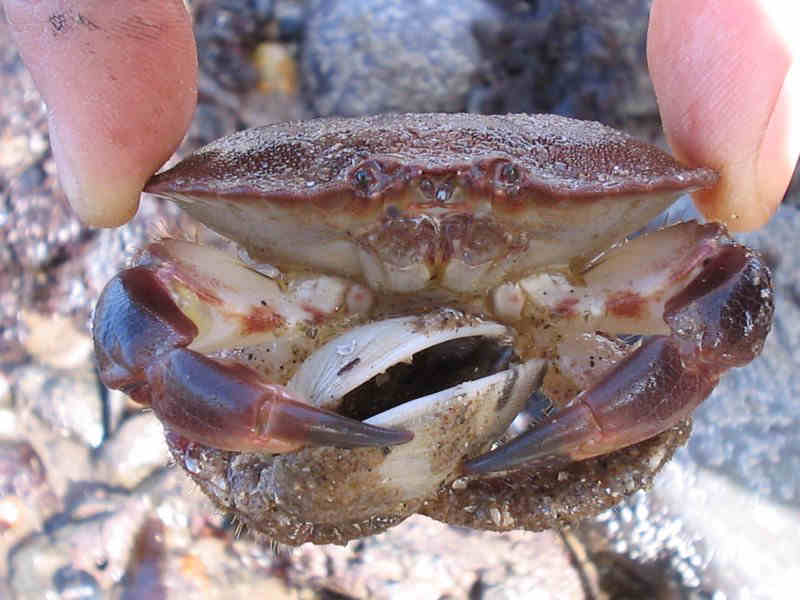Edible crab (Cancer pagurus)
Distribution data supplied by the Ocean Biodiversity Information System (OBIS). To interrogate UK data visit the NBN Atlas.Map Help
| Researched by | Ken Neal & Emily Wilson | Refereed by | This information is not refereed |
| Authority | Linnaeus, 1758 | ||
| Other common names | - | Synonyms | - |
Summary
Description
Crab with a heavy, oval shaped body, easily distinguished from other species by its 'piecrust' edge and massive black tipped pincers. It is reddish-brown in colour with very large individuals having a carapace width of up to 25 cm although individuals are typically up to 15 cm.
Recorded distribution in Britain and Ireland
All British and Irish coasts.Global distribution
From Norway throughout the North Sea and English Channel to the coast of Portugal. Cancer pagurus may penetrate into the Mediterranean Sea and occur in the Black Sea (Anosov, 2000) but this is yet to be confirmed.Habitat
Found on bedrock including under boulders, mixed coarse grounds, and offshore in muddy sand. Lower shore, shallow sublittoral and offshore to about 100 m.Depth range
From intertidal down to 100 mIdentifying features
- Claw pincers black, slightly unequal in shape and toothed.
- Wide, oblong-shaped carapace is distinctively marked along its fronto-lateral margins with 10 rounded lobes.
- Tufts of stiff hairs in rows on legs (pereopods).
- Last leg segment (dactyls) of walking legs ending in spine-like tips.
Additional information
Also known as the brown crab.
Listed by
- none -
Biology review
Taxonomy
| Level | Scientific name | Common name |
|---|---|---|
| Class | Malacostraca | Crabs, lobsters, sand hoppers and sea slaters |
| Family | Cancridae | |
| Genus | Cancer | |
| Authority | Linnaeus, 1758 | |
| Recent Synonyms | ||
Biology
| Parameter | Data | ||
|---|---|---|---|
| Typical abundance | High density | ||
| Male size range | 5-27 cm | ||
| Male size at maturity | 11 cm | ||
| Female size range | 11.5 cm | ||
| Female size at maturity | |||
| Growth form | Articulate | ||
| Growth rate | 0.1-1cm/year | ||
| Body flexibility | None (less than 10 degrees) | ||
| Mobility | Crawler or Walker | ||
| Characteristic feeding method | Predator | ||
| Diet/food source | Planktotroph | ||
| Typically feeds on | A variety of live molluscs and crustaceans as well as carrion | ||
| Sociability | |||
| Environmental position | Epibenthic | ||
| Dependency | No information found. | ||
| Supports | No information | ||
| Is the species harmful? | No | ||
Biology information
Feeding. Cancer pagurus is a large crab typical of hard and soft bottom communities. It is an active predator and consumes a variety of crustaceans (e.g. the green shore crab Carcinus maenas, the broad clawed porcelain crab Porcellana platycheles, the long-clawed porcelain crab Pisidia longicornis, the hairy crab Pilumnus hirtellus and the squat lobster Galathea squamifera) and will also eat smaller members of their own species (conspecifics) (Lawton, 1989). Cancer pagurus also consumes a variety of molluscs e.g. the dog whelk Nucella lapillus, the winkle Littorina littorea (Lawton & Hughes, 1985), razor shells Ensis spp. (Hall et al., 1991), the blue mussel Mytilus edulis, the common cockle Cerastoderma edule and the oyster Ostrea edulis (Mascaro & Seed, 2001). Motile prey may be stalked and pounced upon, trapped under the abdomen and crushed with the chelae. Some prey is also ambushed from shelters under rocks (Lawton, 1989). In sediments, Cancer pagurus may dig large pits to access bivalve molluscs such as Ensis sp. (Hall et al., 1991) and Lutraria lutraria. Cancer pagurus is mainly nocturnal, presumably to reduce predation by wolffish, seals and cod (Skajaa et al., 1998).
Growth. Juveniles settle in the intertidal zone in late summer/ early autumn (Bennett, 1995) and remain there until they reach a carapace width (CW) of 6-7 cm (which takes about 3 years) before they move to subtidal areas (Regnault, 1994). The growth rate varies with age and gender. Between years 4-8 of a male crab's life, it grows at about 1 cm CW per year. After the 8th year, the growth rate slows gradually to about 2 mm per year between its 16th and 20th years. The female growth rate is less, at about 0.5 cm per year between years 4 and 8, declining to 0.1 cm per year between years 16 and 20 (Bennett, 1979). Size can be related to depth. In less than 25 m of water, males and females have a mean CW of 14 cm. Between 25 and 55 m, males are on average 17 cm CW and females 15.8 cm, over 55 m these sizes increase to 18 cm CW for males and 17 cm CW for females (Brown & Bennett, 1980).
Habitat preferences
| Parameter | Data |
|---|---|
| Physiographic preferences | Offshore seabed, Strait or Sound |
| Biological zone preferences | Lower circalittoral, Lower eulittoral, Lower infralittoral, Mid eulittoral, Sublittoral fringe, Upper circalittoral, Upper infralittoral |
| Substratum / habitat preferences | Bedrock, Coarse clean sand, Cobbles, Fine clean sand, Gravel / shingle, Muddy gravel, Muddy sand, Pebbles, Sandy mud |
| Tidal strength preferences | Moderately strong 1 to 3 knots (0.5-1.5 m/sec.), Weak < 1 knot (<0.5 m/sec.) |
| Wave exposure preferences | Exposed, Moderately exposed |
| Salinity preferences | Full (30-40 psu), Variable (18-40 psu) |
| Depth range | From intertidal down to 100 m |
| Other preferences | None |
| Migration Pattern | Non-migratory or resident |
Habitat Information
Adult Cancer pagurus cannot tolerate salinities of 17 psu or lower whereas young (5-10 cm CW) can tolerate reduced salinities for extended periods (Wanson et al., 1983).Life history
Adult characteristics
| Parameter | Data |
|---|---|
| Reproductive type | Gonochoristic (dioecious) |
| Reproductive frequency | Annual episodic |
| Fecundity (number of eggs) | >1,000,000 |
| Generation time | 10-20 years |
| Age at maturity | 10 years + |
| Season | November - February |
| Life span | 20-100 years |
Larval characteristics
| Parameter | Data |
|---|---|
| Larval/propagule type | - |
| Larval/juvenile development | Planktotrophic |
| Duration of larval stage | 1-6 months |
| Larval dispersal potential | Greater than 10 km |
| Larval settlement period | Insufficient information |
Life history information
Mating is by copulation in spring and summer and occurs shortly after the female has moulted (Brown & Bennett, 1980). Females are 'berried' (carrying eggs under the abdomen) for 6-9 months after copulation and release the larvae in late spring/early summer (Thompson et al., 1995). Berried females do not feed, remaining in pits dug in the sediment or under rocks and are unlikely to be caught in a baited pot. As a result, fishing pressure does not affect larval supply (Howard, 1982). Fecundity is between 0.25 and 3 million eggs per female depending on size (Bennett, 1995). Females can store sperm and berried females retained after an experiment went on to produce viable larvae in the following reproductive season without moulting or copulating (Naylor et al., 1999). In the North Sea, berried females migrate offshore to release larvae and then move back inshore to feed (see larval general biology; Nichols et al., 1982).Sensitivity review
The MarLIN sensitivity assessment approach used below has been superseded by the MarESA (Marine Evidence-based Sensitivity Assessment) approach (see menu). The MarLIN approach was used for assessments from 1999-2010. The MarESA approach reflects the recent conservation imperatives and terminology and is used for sensitivity assessments from 2014 onwards.
Physical pressures
Use / to open/close text displayed
| Intolerance | Recoverability | Sensitivity | Evidence / Confidence | |
Substratum loss [Show more]Substratum lossBenchmark. All of the substratum occupied by the species or biotope under consideration is removed. A single event is assumed for sensitivity assessment. Once the activity or event has stopped (or between regular events) suitable substratum remains or is deposited. Species or community recovery assumes that the substratum within the habitat preferences of the original species or community is present. Further details EvidenceSubstrate removal is likely to remove a proportion of Cancer pagurus although some will escape. Those that escape undamaged will quickly recolonize whatever seabed remains and migrate to new habitats if necessary. Therefore an intolerance of intermediate and a recoverability of moderate have been recorded. | Intermediate | Moderate | Moderate | Very low |
Smothering [Show more]SmotheringBenchmark. All of the population of a species or an area of a biotope is smothered by sediment to a depth of 5 cm above the substratum for one month. Impermeable materials, such as concrete, oil, or tar, are likely to have a greater effect. Further details. EvidenceShoreline dumping of coal waste and fly ash in the western North Sea filled in rocky crevices, precluding their use by Cancer pagurus. Crab fisheries have declined in the areas of dumping possibly due to Cancer pagurus avoiding the suspended matter or because the paucity of benthic fauna (i.e. prey) caused by heavy siltation. China clay waste from the Rivers Fal, White and Par in Cornwall had a similar effect (Shelton, 1973). However, crabs are able to escape from under silt and migrate away from an area. Smothering is unlikely to cause mortality therefore an intolerance of low has been recorded. | Low | Very high | Very Low | High |
Increase in suspended sediment [Show more]Increase in suspended sedimentBenchmark. An arbitrary short-term, acute change in background suspended sediment concentration e.g., a change of 100 mg/l for one month. The resultant light attenuation effects are addressed under turbidity, and the effects of rapid settling out of suspended sediment are addressed under smothering. Further details EvidenceShelton (1973) reported that Cancer pagurus avoided areas of spoil dumping and suggested this may be due suspended sediment or due to decreased macrofauna. Cancer pagurus relies on visual acuity to find prey so although mortality due to an increase in suspended sediment is unlikely, some perturbation is expected and low has been recorded. | Low | High | Low | Very low |
Decrease in suspended sediment [Show more]Decrease in suspended sedimentBenchmark. An arbitrary short-term, acute change in background suspended sediment concentration e.g., a change of 100 mg/l for one month. The resultant light attenuation effects are addressed under turbidity, and the effects of rapid settling out of suspended sediment are addressed under smothering. Further details EvidenceCancer pagurus is not reliant on suspended sediment, therefore is unlikely to be affected by a decrease in suspended sediment and tolerant has been recorded. | Tolerant | Not relevant | Not sensitive | |
Desiccation [Show more]Desiccation
EvidenceAdult Cancer pagurus are very unlikely to be subject to desiccation because they are subtidal but are likely to survive at the benchmark level as they can survive up to 24 hours in moist air (Regnault, 1992). The juveniles in the intertidal seek shelter in moist microhabitats under rocks and seaweed (Lawton, 1989) and are likely to survive extended exposure in the short term and will migrate downshore upon emersion on the next high tide. Cancer pagurus survive for long periods in fish boxes waiting to be sold, therefore tolerant has been recorded. | Tolerant | Not relevant | Not sensitive | Low |
Increase in emergence regime [Show more]Increase in emergence regimeBenchmark. A one hour change in the time covered or not covered by the sea for a period of one year. Further details EvidenceIn an experiment on blood chemistry of emersed crabs, 60 Cancer pagurus survived exposure to air but under wet seaweed for 24 hours (Regnault, 1992). However, increased emergence will probably cause them to migrate down shore during a following period of immersion. An increase in emergence is unlikely to cause mortality or perturbation to Cancer pagurus and tolerant has been recorded. | Tolerant | Not relevant | Not sensitive | High |
Decrease in emergence regime [Show more]Decrease in emergence regimeBenchmark. A one hour change in the time covered or not covered by the sea for a period of one year. Further details EvidenceAdult Cancer pagurus are subtidal and are unlikely to be affected by a decrease in emergence. Juveniles less than 3 years of age are mainly intertidal (Regnault, 1994) and a decrease in emergence is likely to be beneficial as it would increase foraging time. Therefore tolerant* has been recorded. | Tolerant* | Not relevant | Not sensitive* | Low |
Increase in water flow rate [Show more]Increase in water flow rateA change of two categories in water flow rate (view glossary) for 1 year, for example, from moderately strong (1-3 knots) to very weak (negligible). Further details EvidenceCancer pagurus is highly chemosensitive and can quickly navigate to bait in a current of 0.1m/s. However, when the current speed rises to 0.3 m/s, only 15% of crabs on sediment could make headway, the others were swept away (Nickell & Moore, 1992). Therefore, crabs in strong current are unlikely to be killed but would probably be able to feed only by digging pits for buried bivalves (Hall et al. 1991) or ambush from the shelter of topographic features (Lawton, 1989), which may affect their rate of growth and maturity. Nevertheless, high current velocity bedrock habitats are likely to have a plentiful supply of food and provide refuge from the current due to habitat complexity and Cancer pagurus may benefit. The greater densities of edible crabs seen by Keith Hiscock (pers. comm.) were seen at the Smalls Rocks, Pembrokeshire and at Strangford Lough Narrows, both areas of very strong currents. Therefore tolerant has been recorded. | Tolerant | Not relevant | Not sensitive | Moderate |
Decrease in water flow rate [Show more]Decrease in water flow rateA change of two categories in water flow rate (view glossary) for 1 year, for example, from moderately strong (1-3 knots) to very weak (negligible). Further details EvidenceA decrease in water movement probably would not affect Cancer pagurus as it does not rely on water movement for feeding or gas exchange and tolerant has been recorded. | Tolerant | Not relevant | Not sensitive | Low |
Increase in temperature [Show more]Increase in temperature
For intertidal species or communities, the range of temperatures includes the air temperature regime for that species or community. Further details EvidenceAny effect from an increase in temperature would depend on the time of year. Adult Cancer pagurus are not tolerant of temperatures over 20°C (Karlsson & Christiansen, 1996) and if an acute change of temperature occurred in summer when sea temperatures are already high, some mortality could occur. However, if an acute rise in temperature occurred in winter the only effect would be an increase in activity associated with a rise in metabolic rate. A chronic increase in temperature is unlikely to affect Cancer pagurus. An intolerance of intermediate has been recorded to account for the worst case scenario. | Intermediate | Very high | Low | Low |
Decrease in temperature [Show more]Decrease in temperature
For intertidal species or communities, the range of temperatures includes the air temperature regime for that species or community. Further details EvidenceCancer pagurus will not feed between 0 and 5°C (Karlsson & Christiansen, 1996) and embryos will not develop below 8°C (Thompson et al., 1995). Therefore if an acute decrease in temperature took the absolute temperature below 5°C, productivity of Cancer pagurus might be affected although mortality is unlikely. A chronic decrease in temperature is unlikely to affect Cancer pagurus at the benchmark level and tolerant has been recorded. | Tolerant | Not relevant | Not sensitive | Low |
Increase in turbidity [Show more]Increase in turbidity
EvidenceThe prey of Cancer pagurus includes various filter feeding bivalves (Hall et al., 1991; Mascaro & Seed, 2001) and filter feeding crabs (Lawton, 1989). The productivity of these prey items is likely to be increased by increased turbidity and thus improve the ratio of effort/predation success by Cancer pagurus and thus improve their productivity as well. An increase in suspended matter may reduce predation from visual predators such as seals and fish but is unlikely to affect the foraging of the crab as this is mainly chemosensory and tolerant* has been recorded. | Tolerant* | Not relevant | Not sensitive* | Very low |
Decrease in turbidity [Show more]Decrease in turbidity
EvidenceAdult Cancer pagurus are not dependent in any way on water-borne particles and are unlikely to be affected by a decrease in turbidity. | Tolerant | Not relevant | Not sensitive | |
Increase in wave exposure [Show more]Increase in wave exposureA change of two ranks on the wave exposure scale (view glossary) e.g., from Exposed to Extremely exposed for a period of one year. Further details EvidenceNo information was found on effect of wave exposure. However, edible crabs are found from very exposed to extremely wave sheltered sites. Wave exposure is likely to reduce activity at times and prevent crabs escaping to shallow depths. Therefore an intolerance of low has been recorded. | Low | Very high | Very Low | Low |
Decrease in wave exposure [Show more]Decrease in wave exposureA change of two ranks on the wave exposure scale (view glossary) e.g., from Exposed to Extremely exposed for a period of one year. Further details EvidenceCancer pagurus occurs in extremely wave sheltered loughs. Decreased wave exposure likelihood of displacement (a favourable effect) and increase food supply but may increase siltation. Overall, Cancer pagurus is probably tolerant to a decrease in wave exposure. | Tolerant | Not relevant | Not sensitive | Low |
Noise [Show more]Noise
EvidenceNo information found | No information | Not relevant | No information | |
Visual presence [Show more]Visual presenceBenchmark. The continuous presence for one month of moving objects not naturally found in the marine environment (e.g., boats, machinery, and humans) within the visual envelope of the species or community under consideration. Further details EvidenceCancer pagurus is nocturnal and has reasonably good eyesight, any lights that are present in the water are likely to affect their activity patterns. Since they are predated upon by seals (Skajaa et al., 1998), large objects in the water such as divers may cause active crabs to seek refuge and inactive ones to remain so. An intolerance of low has been recorded because visual presence is unlikely to cause mortality but will probably alter its behaviour. | Low | Very high | Very Low | Low |
Abrasion & physical disturbance [Show more]Abrasion & physical disturbanceBenchmark. Force equivalent to a standard scallop dredge landing on or being dragged across the organism. A single event is assumed for assessment. This factor includes mechanical interference, crushing, physical blows against, or rubbing and erosion of the organism or habitat of interest. Where trampling is relevant, the evidence and trampling intensity will be reported in the rationale. Further details. EvidenceBerried Cancer pagurus are likely to be disturbed by dredging and trawls as they are relatively immotile and spend most of their time half buried in the sediment (Bennett, 1995). Abrasion is also likely to make Cancer pagurus vulnerable to Burn Spot Disease which may cause some mortality (Austin & Alderman, 1987; Vogan et al., 1999). Cancer pagurus is found in large numbers in scallop (Pecten maximus) beds (pers. obs.) which are commercially exploited by dredging. Cancer pagurus is often damaged or killed if struck by a dredge and annual mortality can be as much as 14% of the population (Bradshaw et al., 1999). Jenkins et al. (2001) found that 63% of Cancer pagurus struck by a scallop dredge sustained damage and 68% of those (43% of the total number struck) were killed. Mortality from otter trawls caused a 50% decline in Cancer pagurus numbers between 1947 and 1960 (Lindeboom, 1999). Cancer pagurus is a rather brittle animal, easily damaged or killed by heavy impacts, and an intolerance of intermediate has been recorded because, although a high proportion of individuals die as a result of scallop dredging, the whole population is unlikely to be affected. | Intermediate | High | Low | High |
Displacement [Show more]DisplacementBenchmark. Removal of the organism from the substratum and displacement from its original position onto a suitable substratum. A single event is assumed for assessment. Further details EvidenceCancer pagurusis tolerant of being hauled into boats in crab pots and returned to the sea, with an increase in metabolic rate the only effect (Aldrich & Regnault, 1990). It also survives well when caught in pots and taken to laboratories and so is tolerant of being displaced within the marine environment (Regnault, 1992; Overnell, 1984). | Tolerant | Not relevant | Not sensitive | Moderate |
Chemical pressures
Use [show more] / [show less] to open/close text displayed
| Intolerance | Recoverability | Sensitivity | Evidence / Confidence | |
Synthetic compound contamination [Show more]Synthetic compound contaminationSensitivity is assessed against the available evidence for the effects of contaminants on the species (or closely related species at low confidence) or community of interest. For example:
The evidence used is stated in the rationale. Where the assessment can be based on a known activity then this is stated. The tolerance to contaminants of species of interest will be included in the rationale when available; together with relevant supporting material. Further details. EvidenceToxicity experiments with the oil dispersant BP1002 showed that a concentration of 10 ppm was required to cause 100% in 24 hours (Smith, 1968). | High | High | Moderate | High |
Heavy metal contamination [Show more]Heavy metal contaminationEvidenceCancer pagurus naturally accumulates metal, and levels of metals in the hepatopancreas have been recorded as high as 200 ppm copper, 29 ppm cadmium and 20 ppm zinc in crabs that were considered uncontaminated by anthropogenic input (Overnell, 1982, 1984). A solution of 1 ppm HgCl2 is lethal to Cancer pagurus (Bianchini & Gilles, 1996) but Cancer pagurus generally seems to be tolerant of metal pollution. Copper and zinc affected arterial blood oxygen levels and caused an increase in heart rate when accompanied by mild hypoxia (Spicer & Weber, 1992). Solutions containing cadmium significantly inhibited gill adenosine phospatase (ATPase) activity at 10 and 100 ppm in short pulses (Law, 1982). Protracted exposure to low concentrations of cadmium lead to a 22% drop in gill ATPase activity which will affect the crabs ability to control the ionic balance of the body tissues (as this is one of the main requirements of adenosine triphosphate (ATP) in the gill) (Law, 1982). Apart from mercury, most metals seem to be non-toxic to Cancer pagurus as they are sequestered by metallothioneins and stored in the hepatopancreas for excretion later (Knowles et al., 1998; Overnell, 1982; 1984; 1986; Smith et al., 1998). Due to the detoxification of metals with metallothioneins, Cancer pagurus is unlikely to suffer mortality unless inputs are very high and an intolerance of low has been recorded. | Low | High | Low | High |
Hydrocarbon contamination [Show more]Hydrocarbon contaminationEvidenceAdult Cancer pagurus are unlikely to be directly oiled because they are subtidal. Many intertidal juveniles were found dead after the Torrey Canyon oil spill and some dead adults were found subtidally, although healthy individuals were found as well (Smith, 1968). The adults affected subtidally may have been killed by dispersants and not oil. After the Sea Empress oil spill, Cancer pagurus were found to have total hydrocarbon content of 10 mg/kg wet weight in claw meat and 20 mg/kg wet weight in the hepatopancreas (Law et al., 1997). Paradoxically, this increased the Cancer pagurus population in the region of the Sea Empress spill since the 0.1 - 2.4 mg/kg wet weight concentrations of polycyclic aromatic hydrocarbons (PAHs) tainted the flesh of the crab and led to the closure of the fishery for at least a year eliminating fishing mortality (SEEEC, 1998; Law et al., 1998). Cancer pagurus in the vicinity of the Braer oil spill contained more than 12 times the PAH concentration of unaffected crabs (Topping et al., 1997). As with the Sea Empress, no mortality resulted from PAH contamination but the crab fishery was closed for a short time to allow PAH elimination (Topping et al., 1997). An intolerance of intermediate has been recorded to account for the worst case of juveniles being killed by oiling and possibly affecting the future of the population. | Intermediate | High | Low | High |
Radionuclide contamination [Show more]Radionuclide contaminationEvidenceCancer pagurus accumulates technetium, a radionuclide of anthropogenic origin, in the hepatopancreas bound by metallothionein (Knowles et al., 1998). Accumulated metal can be excreted once exposure has ceased and experimental Cancer pagurus cleared half of the accumulated technetium in about 100 days (Smith et al., 1998). Due to the detoxification of metal by binding it to metallothioneins, Cancer pagurus may be tolerant but the effect of radiation during decay of radionuclides is unknown. Therefore no assessment of intolerance has been made. | No information | Not relevant | No information | High |
Changes in nutrient levels [Show more]Changes in nutrient levelsEvidenceAnthropogenic sources of nutrients may cause blooms of phytoplankton which collapse and precipitate onto the benthos and can cause localised bottom water hypoxia. In a benthic survey after such a bloom collapse, a few dead Cancer pagurus were found but most were healthy, probably because it is tolerant of hypoxia (see oxygenation). However, benthic bivalves such as Ensis were found dead and moribund (Boalch, 1978). Immediately after the precipitation of the bloom, foraging by Cancer pagurus was probably improved as it preys upon Ensis (Hall et al., 1991). However, if the bivalve populations were slow to recover, population dynamics on Cancer pagurus may be affected. On the rocky shore, nutrient input has been shown to increase productivity of grazers due to increased algal growth (Rogers, 2003). Since juvenile Cancer pagurus consume intertidal gastropods (Lawton & Hughes, 1985), an increase in prey biomass is likely to benefit growth of Cancer pagurus. Tolerant has been recorded because Cancer pagurus is unlikely to be directly affected by nutrient input and there could be positive and negative effects on the prey of Cancer pagurus. | Tolerant | Not relevant | Not sensitive | Very low |
Increase in salinity [Show more]Increase in salinity
EvidenceCancer pagurus is an osmoconformer (Wanson et al., 1983) and is probably tolerant to slight increases in salinity but may be affected by acute increases. However, no information has been found on the effect of hypersaline conditions on Cancer pagurus and therefore no assessment has been made. | No information | Very high | No information | Low |
Decrease in salinity [Show more]Decrease in salinity
EvidenceAdult Cancer pagurus are osmoconformers, meaning that they maintain the ionic balance of the haemolymph at a similar concentration to the surrounding water but they are intolerant of salinities below 17 psu. Juveniles (5-10 cm CW) are mainly intertidal and are tolerant of low salinities (Wanson et al., 1983). Cancer pagurus loses osmoregulatory ability when it moves from the intertidal to the subtidal at about 3 years of age (Regnault, 1992). Intertidal populations of Cancer pagurus are probably tolerant of decreases in salinity. However, subtidal adults are likely to be adversely affected by low salinities e.g. from hyposaline effluents. Cancer pagurus is a very mobile species and would probably avoid hyposaline water and therefore an intolerance of low has been recorded. | Low | High | Low | High |
Changes in oxygenation [Show more]Changes in oxygenationBenchmark. Exposure to a dissolved oxygen concentration of 2 mg/l for one week. Further details. EvidenceCancer pagurus responds to hypoxia by increasing the efficiency of oxygen extraction from the water by its gills (Aldrich & Regnault, 1992; Spicer & Weber, 1992). Cancer pagurus can survive for at least 18 hours in oxygen-depleted conditions (Spicer & Weber, 1992) and can probably survive longer. | Tolerant | Very high | Not sensitive | High |
Biological pressures
Use [show more] / [show less] to open/close text displayed
| Intolerance | Recoverability | Sensitivity | Evidence / Confidence | |
Introduction of microbial pathogens/parasites [Show more]Introduction of microbial pathogens/parasitesBenchmark. Sensitivity can only be assessed relative to a known, named disease, likely to cause partial loss of a species population or community. Further details. EvidenceCancer pagurus can contract Burn Spot Disease and Pink Crab Disease. The former is caused by bacterial (especially species of Vibrio) or fungal infections of epicuticular penetrations caused by abrasions or intraspecific aggression (Austin & Alderman, 1987; Vogan et al., 1999). Burn Spot Disease causes blackened lesions of the shell and melanisation of the flesh, which decreases the market value of the crab (Vogan et al., 1999). Mortality occurs in extreme infections when bacteria penetrate the shell and enter the body fluids or when lesions cause the old shell to stick to the crab during moulting (Austin & Alderman, 1987; Vogan et al., 1999). Prevalence of the disease can be high, e.g. 55% of crabs in Langland Bay, Gower had lesions and infection levels can be higher in heavily polluted waters. Cancer pagurus can rid itself of shell disease by moulting (Vogan et al., 1999). Pink Crab Disease is so named because affected crabs become hyperpigmented and it is caused by an infection of a Hematodinium-like dinoflagellate. It is a rare disease but infected individuals become moribund and mortality is high (Stentiford et al., 2002). An intolerance of intermediate has been recorded. | Intermediate | Moderate | Moderate | High |
Introduction of non-native species [Show more]Introduction of non-native speciesSensitivity assessed against the likely effect of the introduction of alien or non-native species in Britain or Ireland. Further details. EvidenceCancer pagurus is not known to compete with or be affected by any non-native species. | Not relevant | Not relevant | Not relevant | Not relevant |
Extraction of this species [Show more]Extraction of this speciesBenchmark. Extraction removes 50% of the species or community from the area under consideration. Sensitivity will be assessed as 'intermediate'. The habitat remains intact or recovers rapidly. Any effects of the extraction process on the habitat itself are addressed under other factors, e.g. displacement, abrasion and physical disturbance, and substratum loss. Further details. EvidenceAll around Britain and Ireland there are substantial fisheries for Cancer pagurus (Bennett 1979; 1995; Brown & Bennett, 1980; Eaton et al., 2001; Fahy, et al., 2002; Howard, 1982), which although causing significant mortality, are regulated by minimum landing sizes introduced in the 19th century. Also the biology of Cancer pagurus protects the sustainability of the fishery as berried females do not feed and are rarely caught in baited pots (Howard, 1982). Therefore an intolerance of intermediate has been recorded. | Intermediate | High | Low | High |
Extraction of other species [Show more]Extraction of other speciesBenchmark. A species that is a required host or prey for the species under consideration (and assuming that no alternative host exists) or a keystone species in a biotope is removed. Any effects of the extraction process on the habitat itself are addressed under other factors, e.g. displacement, abrasion and physical disturbance, and substratum loss. Further details. EvidenceMany of the prey items of Cancer pagurus are also commercially exploited especially large bivalves. If populations of prey items were overexploited it is likely that the populations of Cancer pagurus would either decrease or growth would be slower leading to later maturation. | Low | Very high | Very Low | Very low |
Additional information
RecoverabilityFemale Cancer pagurus have high fecundity of 0.25 - 3 million eggs per spawning (Bennett, 1995) but mortality of larvae is high. Since juveniles spend the first 3 years post -settlement in the intertidal (Regnault, 1994), recovery of an adult population from a mortality event is likely to take several years. If Cancer pagurus were to be completely eradicated from an area, repopulation would occur by larval input from surrounding areas and adult migration (Bennett & Brown, 1983; 1976). Due to circular water movements, it is thought that at least the population around the Dogger Bank, near northeast England may self contained (Eaton et al., 2001) and other populations around the British Isles may be isolated from larval supply from adjacent populations as well.
Importance review
Policy/legislation
- no data -
Status
| National (GB) importance | - | Global red list (IUCN) category | - |
Non-native
| Parameter | Data |
|---|---|
| Native | Native |
| Origin | Not relevant |
| Date Arrived | NA |
Importance information
In 1980, the fishery of Cancer pagurus was worth £3 million in England and Wales (Howard, 1982) and the area between Brixham and Plymouth accounted for 60% of landings (Brown & Bennett, 1980). Landings for the English Channel fishery amount to approximately 10,000 tonnes annually.The southwest England fishery extends from Beachy Head to Lands End (Brown and Bennett, 1980) and there are also significant fisheries in North Norfolk, close to the River Humber (Eaton et al., 2001) and off the south-east Irish coast (Fahy et al., 2002). Cancer pagurus is caught in baited traps and highest catches are from June to November when large numbers of non-berried females are caught (Brown & Bennett, 1980). The males fetch a higher price as they are larger and females are usually processed into frozen white and brown meat (Brown & Bennett, 1980) or sold as bait for whelks Buccinum undatum (Fahy et al., 2002). Landings in the UK are restricted to crabs of a certain carapace width (CW). This Minimum Landing Size (MLS) varies somewhat. For example, the MLS for males is 16 cm in both Devon and Cornwall although for females it is 14 and 15 cm respectively. In Dorset and Hampshire the MLS if 14 cm for both male and female brown crabs. Because of the poor quality of the flesh, landing of berried or recently moulted ('soft' crabs) is banned (Brown & Bennett, 1980).
Bibliography
Aldrich, J.C. & Regnault, M., 1990. Individual variations in the response to hypoxia in Cancer pagurus (L.) measured at the excited rate. Marine Behaviour and Physiology, 16, 225-235.
Anosov, S.E., 2000. Keys to the identification of brachyuran larvae of the Black Sea. Crustaceana, 73, 1239-1246.
Austin, B. & Alderman, D.J., 1987. Bacterial shell disease of crustaceans. Identification leaflets for Diseases and Parasites of Fish and Shellfish, 31, 4 pp., ICES Copenhagen (Denmark).
Bennett, D.B. & Brown, C.G., 1983. Crab (Cancer pagurus) migrations in the English Channel. Journal of the Marine Biological Association of the United Kingdom, 63, 371-398.
Bennett, D.B., 1979. Population assessment of the edible crab (Cancer pagurus L.) fishery off southwest England. Rapports et Proces-verbaux des Reunions. Conseil International pour l'Exploration de la Mer, 175, 229-235.
Bennett, D.B., 1995. Factors in the life history of the edible crab (Cancer pagurus L.) that influence modelling and management. ICES Marine Science Symposia, 199, 89-98.
Bianchini, A. & Gilles, R., 1996. Toxicity and accumulation of mercury in three species of crabs with differing osmoregulatory capacities. Bulletin of Environmental Contamination and Toxicology, 57, 91-98.
Boalch, G.T., 1979. The dinoflagellate bloom on the coast of south-west England, August to September 1978. Journal of the Marine Biological Association of the United Kingdom, 59, 515-517.
Bradshaw, C., Veale, L.O., Hill, A.S. & Brand, A.R., 2000. The effects of scallop dredging on gravelly seabed communities. In: Effects of fishing on non-target species and habitats (ed. M.J. Kaiser & de S.J. Groot), pp. 83-104. Oxford: Blackwell Science.
Brown, C.G. & Bennett, D.B., 1980. Population and catch structure of the edible crab (Cancer pagurus) in the English Channel. Journal du Conseil, 39, 88-100.
Eaton, D.R., Addison, J.T., Milligan, S.P., Brown, J. & Fernand, L.J., 2001. Larvae surveys of edible crab (Cancer pagurus) off the east coast of England: implications for stock structure and management. ICES Council Meeting Papers, C.M. J:14 10 p.
Eaton, D.R., Brown, J., Addison, J.T., Milligan, S.P. & Fernand, L.J., 2003. Edible crab (Cancer pagurus) larvae surveys off the east coast of England: implications for stock structure. Fisheries Research, 65, 191-199.
Edwards, E., 1979. The Edible Crab and its fishery in British Waters. Surrey, England: Fishing News Books Ltd.
Eleftheriou, A. & Robertson, M.R., 1992. The effects of experimental scallop dredging on the fauna and physical environment of a shallow sandy community. Netherlands Journal of Sea Research, 30, 289-299.
Fahy, E., Carroll, J. & Stokes, D., 2002. The inshore pot fishery for brown crab (Cancer pagurus), landing into south east Ireland: estimate of yield and assessment of status. Irish Fisheries Investigations, 11, 26 p.
Hall, S.J., Basford, D.J., Robertson, M.R., Raffaelli, D.G. & Tuck, I., 1991. Patterns of recolonisation and the importance of pit-digging by the crab Cancer pagurus in a subtidal sand habitat. Marine Ecology Progress Series, 72, 93-102.
Harms, J. & Seeger, B., 1989. Larval development and survival in seven decapod species (Crustacea) in relation to laboratory diet. Journal of Experimental Marine Biology and Ecology, 133, 129-139.
Hartnoll, R.G. & Mohamedeen, H., 1987. Laboratory growth of the larvae of six British crabs. Journal of Experimental Marine Biology and Ecology, 107, 155-170.
Howard, A.E., 1982. The distribution and behaviour of ovigerous edible crabs (Cancer pagurus), and consequent sampling bias. Journal du Conseil, 40, 259-261.
Howson, C.M. & Picton, B.E., 1997. The species directory of the marine fauna and flora of the British Isles and surrounding seas. Belfast: Ulster Museum. [Ulster Museum publication, no. 276.]
Jenkins, S.R., Beukers-Stewart, B.D. & Brand, A.R., 2001. Impact of scallop dredging on benthic megafauna: a comparison of damage levels in captured and non-captured organisms. Marine Ecology Progress Series, 215, 297-301. DOI https://doi.org/10.3354/meps215297
Karlsson, K. & Christiansen, M.E., 1996. Occurrence and population composition of the edible crab (Cancer pagurus) on rocky shores of an islet on the south coast of Norway. Sarsia, 81, 307-314.
Knowles, J.F., Smith, D.L. & Winpenny, K., 1998. A comparative study of the uptake, clearance and metabolism of technetium in lobster (Homarus gammarus) and edible crab (Cancer pagurus). Radiation Protection Dosimetry, 75, 125-129.
Law, R.J., Kelly, C.A., Grahan, K.L., Woodhead, R.J., Dyrynda, P.E.J. & Dyrynda, E.A., 1997. Hydrocarbons and PAH in fish and shellfish from southwest Wales following the Sea Empress oil spill in 1996. In: American Petroleum Institute. Proceedings. 1997 International Oil Spill Conference. pp 205-211., Washington DC: American Petroleum Institute.
Law, R.J., Thain, J.E., Kirby, M.F., Allen, Y.T., Lyons, B.P., Kelly, C.A. et al., 1998. The impact of the Sea Empress oil spill on fish and shellfish. In: The Sea Empress oil spill, (ed. R. Edwards & H. Sime) pp 109-136. Lavenham: Lavenham Press.
Law, T., 1982. The uptake, distribution and biochemical effects of cadmium in the edible crab Cancer pagurus. (M.Phil. thesis), M.Phil. Thesis, Bristol Polytechnic, Science Department.
Lawton, P. & Hughes, R.N., 1985. Foraging behaviour of the crab Cancer pagurus feeding on the gastropods Nucella lapillus and Littorina littorea: comparisons with optimal foraging theory. Marine Ecology Progress Series, 27, 147-154.
Lawton, P., 1989. Predatory interaction between the brachyuran crab Cancer pagurus and decapod crustacean prey. Marine Ecology Progress Series, 52, 169-179.
Mascaro, M. & Seed, R., 2001. Foraging behaviour of juvenile Carcinus maenus (L.) and Cancer pagurus (L.). Marine Biology, 139, 1135-1145.
Naylor, J.K., Taylor, E.W. & Bennett, D.B., 1999. Oxygen uptake of developing eggs of Cancer pagurus (Crustacea: Decapoda: Cancridae) and consequent behaviour of ovigerous females. Journal of the Marine Biological Association of the United Kingdom, 79, 305-315.
Nichols, J.H., Thompson, B.M. & Cryer, M. 1982. Production, drift and mortality of the planktonic larvae of the edible crab (Cancer pagurus) off the north-east coast of England. Netherlands Journal of Sea Research, 16, 173-184.
Nickell, T.D. & Moore, P.G., 1992. The behavioural ecology of epibenthic scavenging invertebrates in the Clyde Sea area: laboratory experiments on attractions to bait in moving water, underwater TV observations in situ and general conclusions. Journal of Experimental Marine Biology and Ecology, 159, 15-35.
Overnell, J., 1982. Copper metabolism in crabs and metallothionein: In vivo effects of copper(II) on soluble hepatopancreas metal binding components of the crab Cancer pagurus containing varying amounts of cadmium. Comparative Biochemistry and Physiology, 73B, 555-564.
Overnell, J., 1984. The partition of copper and cadmium between different charge-forms of metallothionein in the digestive tubules of the crab, Cancer pagurus. Comparative Biochemistry and Physiology, 77C, 237-243.
Regnault, M., 1992. Effect of air exposure on nitrogen metabolism in the crab Cancer pagurus. Journal of Experimental Zoology, 264, 372-380.
Regnault, M., 1994. Effect of air exposure on ammonia excretion and ammonia content of branchial water of the crab Cancer pagurus. Journal of Experimental Zoology, 268, 208-217.
Robinson, M. & Tully, O., 2000. Seasonal variation in community structure and recruitment of benthic decapods in a sub-tidal cobble habitat. Marine Ecology Progress Series, 206, 181-191.
Rogers, K.M., 2003. Stable carbon and nitrogen isotope signatures indicate recovery of marine biota from sewage pollution at Moa Point, New Zealand. Marine Pollution Bulletin, 46, 821-827.
SEEEC (Sea Empress Environmental Evaluation Committee), 1998. The environmental impact of the Sea Empress oil spill. Final Report of the Sea Empress Environmental Evaluation Committee, 135 pp., London: HMSO.
Shelton, R.G.J., 1973. Some effects of dumping, solid wastes on marine life and fisheries. In: North Sea Science (ed. E.D. Goldberg) pp 415-436. London: The MIT Press.
Skajaa, K., Ferno, A., Lokkeborg, S. & Haugland, E.K., 1998. Basic movement pattern and chemo-oriented search towards baited pots in edible crab (Cancer pagurus L.). Hydrobiologia, 371/372, 143-153.
Smith, D.L., Knowles, J.F. & Winpenny, K., 1998. The accumulation, retention and distribution of 95mTc in crab (Cancer pagurus L.) and lobster (Homarus gammarus L.). A comparative study. Journal of Environmental Radioactivity, 40, 113-135.
Smith, J.E. (ed.), 1968. 'Torrey Canyon'. Pollution and marine life. Cambridge: Cambridge University Press.
Spicer, J.I. & Weber, R.E., 1992. Respiratory impairment by water-borne copper and zinc in the edible crab Cancer pagurus (L.) (Crustacea: Decapoda) during hypoxic exposure. Marine Biology, 112, 429-435.
Stentiford, G.D, Green, M., Bateman, K., Small, H.J., Neil, D.M. & Feist, S.W., 2002. Infection by a Hematodinium-like parasitic dinoflagellate causes Pink Crab Disease (PCD) in the edible crab Cancer pagurus. Journal of Invertebrate Pathology, 79, 179-191.
Thompson, B.M., Lawler, A.R. & Bennett, D.B., 1995. Estimation of the spatial distribution of spawning crabs (Cancer pagurus L.) using larval surveys of the English Channel. ICES Marine Science Symposia, 199, 139-150.
Topping, G. Davies, J.M., Mackie, P.R. & Moffat, C.F., 1997. The impact of the Braer spill on commercial fish and shellfish. In The impact of an oil spill in turbulent waters: The Braer, pp.121-143. Edinburgh: The Stationery Office Limited.
Torres, G., Giménez, L. & Anger, K., 2002. Effects of reduced salinity on the biochemical composition (lipid, protein) of zoea 1 decapod larvae. Journal of Experimental Marine Biology and Ecology, 277, 43-60.
Vogan, C.L., Llewellyn, P.J. & Rowley, A.F., 1999. Epidemiology and dynamics of shell disease of the edible crab Cancer pagurus: a preliminary study of Langland Bay, Swansea, UK. Diseases of Aquatic Organisms, 35, 81-87.
Wanson, S., Pequeux, A. & Giles, R., 1983. Osmoregulation in the stone crab Cancer pagurus. Marine Biology Letters, 4, 321-330.
Datasets
Bristol Regional Environmental Records Centre, 2017. BRERC species records recorded over 15 years ago. Occurrence dataset: https://doi.org/10.15468/h1ln5p accessed via GBIF.org on 2018-09-25.
Bristol Regional Environmental Records Centre, 2017. BRERC species records within last 15 years. Occurrence dataset: https://doi.org/10.15468/vntgox accessed via GBIF.org on 2018-09-25.
Centre for Environmental Data and Recording, 2018. IBIS Project Data. Occurrence dataset: https://www.nmni.com/CEDaR/CEDaR-Centre-for-Environmental-Data-and-Recording.aspx accessed via NBNAtlas.org on 2018-09-25.
Centre for Environmental Data and Recording, 2018. Ulster Museum Marine Surveys of Northern Ireland Coastal Waters. Occurrence dataset https://www.nmni.com/CEDaR/CEDaR-Centre-for-Environmental-Data-and-Recording.aspx accessed via NBNAtlas.org on 2018-09-25.
Cofnod – North Wales Environmental Information Service, 2018. Miscellaneous records held on the Cofnod database. Occurrence dataset: https://doi.org/10.15468/hcgqsi accessed via GBIF.org on 2018-09-25.
Environmental Records Information Centre North East, 2018. ERIC NE Combined dataset to 2017. Occurrence dataset: http://www.ericnortheast.org.ukl accessed via NBNAtlas.org on 2018-09-38
Fenwick, 2018. Aphotomarine. Occurrence dataset http://www.aphotomarine.com/index.html Accessed via NBNAtlas.org on 2018-10-01
Fife Nature Records Centre, 2018. St Andrews BioBlitz 2014. Occurrence dataset: https://doi.org/10.15468/erweal accessed via GBIF.org on 2018-09-27.
Fife Nature Records Centre, 2018. St Andrews BioBlitz 2015. Occurrence dataset: https://doi.org/10.15468/xtrbvy accessed via GBIF.org on 2018-09-27.
Fife Nature Records Centre, 2018. St Andrews BioBlitz 2016. Occurrence dataset: https://doi.org/10.15468/146yiz accessed via GBIF.org on 2018-09-27.
Isle of Wight Local Records Centre, 2017. IOW Natural History & Archaeological Society Marine Invertebrate Records 1853- 2011. Occurrence dataset: https://doi.org/10.15468/d9amhg accessed via GBIF.org on 2018-09-27.
Kent Wildlife Trust, 2018. Biological survey of the intertidal chalk reefs between Folkestone Warren and Kingsdown, Kent 2009-2011. Occurrence dataset: https://www.kentwildlifetrust.org.uk/ accessed via NBNAtlas.org on 2018-10-01.
Kent Wildlife Trust, 2018. Kent Wildlife Trust Shoresearch Intertidal Survey 2004 onwards. Occurrence dataset: https://www.kentwildlifetrust.org.uk/ accessed via NBNAtlas.org on 2018-10-01.
Lancashire Environment Record Network, 2018. LERN Records. Occurrence dataset: https://doi.org/10.15468/esxc9a accessed via GBIF.org on 2018-10-01.
Manx Biological Recording Partnership, 2017. Isle of Man wildlife records from 01/01/2000 to 13/02/2017. Occurrence dataset: https://doi.org/10.15468/mopwow accessed via GBIF.org on 2018-10-01.
Manx Biological Recording Partnership, 2018. Isle of Man historical wildlife records 1990 to 1994. Occurrence dataset: https://doi.org/10.15468/aru16v accessed via GBIF.org on 2018-10-01.
Manx Biological Recording Partnership, 2018. Isle of Man historical wildlife records 1995 to 1999. Occurrence dataset: https://doi.org/10.15468/lo2tge accessed via GBIF.org on 2018-10-01.
Manx Biological Recording Partnership, 2022. Isle of Man historical wildlife records 1990 to 1994. Occurrence dataset:https://doi.org/10.15468/aru16v accessed via GBIF.org on 2024-09-27.
Merseyside BioBank., 2018. Merseyside BioBank (unverified). Occurrence dataset: https://doi.org/10.15468/iou2ld accessed via GBIF.org on 2018-10-01.
Merseyside BioBank., 2018. Merseyside BioBank Active Naturalists (unverified). Occurrence dataset: https://doi.org/10.15468/smzyqf accessed via GBIF.org on 2018-10-01.
National Trust, 2017. National Trust Species Records. Occurrence dataset: https://doi.org/10.15468/opc6g1 accessed via GBIF.org on 2018-10-01.
NBN (National Biodiversity Network) Atlas. Available from: https://www.nbnatlas.org.
Norfolk Biodiversity Information Service, 2017. NBIS Records to December 2016. Occurrence dataset: https://doi.org/10.15468/jca5lo accessed via GBIF.org on 2018-10-01.
OBIS (Ocean Biodiversity Information System), 2025. Global map of species distribution using gridded data. Available from: Ocean Biogeographic Information System. www.iobis.org. Accessed: 2025-04-25
Outer Hebrides Biological Recording, 2018. Invertebrates (except insects), Outer Hebrides. Occurrence dataset: https://doi.org/10.15468/hpavud accessed via GBIF.org on 2018-10-01.
South East Wales Biodiversity Records Centre, 2018. SEWBReC Myriapods, Isopods, and allied species (South East Wales). Occurrence dataset: https://doi.org/10.15468/rvxsqs accessed via GBIF.org on 2018-10-02.
South East Wales Biodiversity Records Centre, 2018. Dr Mary Gillham Archive Project. Occurance dataset: http://www.sewbrec.org.uk/ accessed via NBNAtlas.org on 2018-10-02
The Wildlife Information Centre, 2018. TWIC Biodiversity Field Trip Data (1995-present). Occurrence dataset: https://doi.org/10.15468/ljc0ke accessed via GBIF.org on 2018-10-02.
Yorkshire Wildlife Trust, 2018. Yorkshire Wildlife Trust Shoresearch. Occurrence dataset: https://doi.org/10.15468/1nw3ch accessed via GBIF.org on 2018-10-02.
Citation
This review can be cited as:
Last Updated: 08/05/2008


